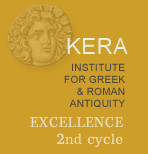Main Site . Dikmen Tepe/Boubon
1. Fragment of a Hellenistic treaty
![]()
|
''– – – – – – – – – – – – – – – – – – – – – – – – – – – – – - - -
[– – – – - -]Σ̣[ . . ]Ο̣[ ̣ – – – – – – – – – – – – – – – – – – – – ] [ – – –πρὸ]ς Οἰνοά[νδοις – – – – – – – – – – – – – – – – –] [ – – –]β̣οῦντες τοῖς κ̣[αιροῖς βοιηθήσομεν, ἀγω-] [νιζόμενοι καὶ] λόγῳ καὶ ἔργοις καὶ ὅπλ̣[οις, σπουδῆς καὶ] [φιλοτιμίας μ]ηθὲν ἐλλίποντες κατὰ δύν[αμιν τὴν ἡμῶν] [αὐτῶν, διατηρ]οῦντες καὶ τὴν πρὸς Ῥωμαίους [τοὺς κοι-] [νοὺς σωτὴρας] καὶ εὐεργέτας εὔνοιάν τε καὶ συνμα̣[χίαν,] [μηθὲν ὑπεναντ]ίο̣ν πράσοντες τοῖς ἐκείνων δόγμ̣[ασιν]''. [ὀμοῦνται δ' αἱ διαλ]λ̣α̣σ̣[σό]μ̣̣εναι τρεῖς πόλεις δι' ἐντόμ[ων] [νεοκαύτων -- ca. 7 -- τούς ὅρκο]υ̣ς̣ τὸν ὑπογεγ[ραμμένον] [τρόπον κ.τ.λ.] |
"[We swear...by Zeus (? for example)... that if we perceive that anyone plots against/attacks... the Boubonians, the Balbourans, or the Termessians at] Oinoanda, [or their territories(?), then...] as god-fearing men we will come to [their aid] in [time of peril, striving] by word, and deeds, and with arms, abating none of [our zeal and spirit], to the best of [our] ability, preserving the treaty of goodwill and alliance with the Romans, [the Common Saviours] and Benefactors, doing [nothing] contrary to their decrees." [The] three cities being reconciled [will also swear the oaths] over [new-burnt... ] victims, in the [manner] written below... (Trans. Milner 2000, p. 158)
Limestone fragment broken all round and at the back, found in a rescue excavation of a rectangular public building, with a nearly north–south orientation, located between the theater and the agora. The building suggests in plan the remains of a small temple, and was constructed almost entirely of spolia. One series of architectural members among the spolia may have belonged to a single, probably Hellenistic, building constructed in the Doric order. The excavation was conducted in 1993 by H. A. Ekinci (Burdur Museum) (Ekinci 1995, pp. 333-343).
Height: ca. 12 cm; length: ca. 24 cm; letters: 0.8-1 cm.
Ekinci 1995, pp. 333-343; Milner 2007 (pl. XXI: photograph of the stone and scale-drawing based on a squeeze).
The fragment belongs to the part of the treaty which specified oaths to be taken by the allied parties. The oath quoted in ll. 1-8 mentions an already existing alliance with Rome (l. 6). As Cibyra is known to have had a treaty with Rome (IK Kibyra I, no. 1), Milner argues that the oath of ll. 1-8 is most likely one that would be sworn by the Cibyrates. The other side in the treaty must have been represented by the "three cities" mentioned in l. 9. Those were most likely Oinoanda (l. 3), Boubon (certainly involved since it is the find spot of the inscription), and Balboura, Boubon's eastern neighbor. The treaty, then, was most likely one between Cibyra on one side, and its three southern neighbors on the other. The three cities and Cibyra are known to have formed a Tetrapolis (Strabo 13.4.17), probably in the second century BCE. Milner's thorough study of this text concludes that it must belong to the period shortly after 167 BCE, when a switch in Roman support for Rhodes freed Lycia from Rhodian control. This may in fact be the foundation document of the Tetrapolis. The contraction of Rhodian power supplied Cibyra with an opportunity for a new relationship with Rome, and for the creation of a political league with neighboring cities. See Milner's detailed commentary. Note in l. 9 the rarely attested word ἔντομα for sacrificial victims.

